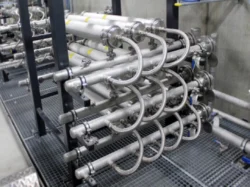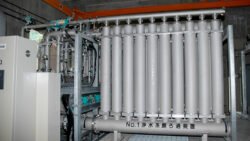Electrospun Metal-Organic Framework Membranes
Electrospun Metal-Organic Framework Membranes: A Revolutionary Approach in Material Science
Introduction
Electrospun Metal-Organic Framework (MOF) membranes represent an exciting frontier in material science, combining the advantages of electrospinning and MOFs to yield materials with unique and highly tunable properties. The union of these two technologies has opened new pathways for applications in filtration, catalysis, sensing, and energy storage, among other fields. This article delves into the intricacies of electrospun MOF membranes, exploring their synthesis, properties, and potential applications.
Metal-Organic Frameworks (MOFs)
MOFs are crystalline compounds comprised of metal ions coordinated to organic ligands, forming one-, two-, or three-dimensional porous structures. The unique feature of MOFs is their tunable porosity and functionality, which can be customized by altering the metal clusters or organic linkers. This customization allows for precise control over the pore size and surface properties, making MOFs incredibly versatile for various applications.
Properties of MOFs
The key properties that make MOFs attractive include:
-
- High Surface Area: MOFs can have surface areas exceeding 6,000 m²/g, which is beneficial for applications requiring high adsorptive capacities.
-
- Tailorable Pore Sizes: The pore size in MOFs can range from micropores to mesopores, making them suitable for selectively adsorbing molecules of different sizes.
-
- Chemical Functionalization: The ability to modify the organic linkers or metal nodes allows for the introduction of specific chemical functionalities, enhancing selectivity and reactivity.
Applications of MOFs
Due to their customizable nature, MOFs are used in a wide range of applications, such as:
-
- Gas Storage: MOFs can store significant amounts of gases like hydrogen, methane, and carbon dioxide due to their high surface area.
-
- Catalysis: MOFs can serve as catalysts or support for catalysts in various chemical reactions.
-
- Drug Delivery: The porous structure of MOFs can be used to encapsulate drugs and release them in a controlled manner.
-
- Sensing: MOFs can be tailored to detect specific chemicals through changes in their physical or chemical properties.
Electrospinning: An Overview
Electrospinning is a versatile technique that produces continuous fibers from a polymer solution or melt using an electric field. The resultant fibers can have diameters ranging from nanometers to micrometers, depending on parameters such as solution viscosity, electric field strength, and solvent volatility.
Process of Electrospinning
-
- Solution Preparation: A polymer solution is prepared, typically involving a polymer dissolved in a volatile solvent.
-
- Application of Electric Field: The solution is fed through a syringe with a metallic needle, and a high voltage is applied between the needle and a collector plate.
-
- Fiber Formation: As the solution exits the needle, it forms a jet that undergoes elongation and thinning due to electrostatic repulsion, resulting in the formation of fine fibers.
-
- Collection of Fibers: The fibers are collected on the collector plate, forming a non-woven mat.
Benefits of Electrospinning
-
- High Surface Area: Electrospun fibers have a high surface-to-volume ratio.
-
- Porosity: The non-woven mats formed are highly porous, allowing for high flux in filtration applications.
-
- Scalability: The process can be scaled up for industrial applications.
Synthesis of Electrospun MOF Membranes
The synthesis of electrospun MOF membranes involves combining the electrospinning process with the integration of MOFs into the fiber matrix. There are several approaches to achieve this integration, each with its advantages and limitations.
Direct Electrospinning of MOF/Polymer Solutions
In this approach, MOF particles are dispersed directly into a polymer solution, which is then electrospun to form composite fibers. The MOFs are embedded within the polymer matrix, providing structural support and maintaining the porosity and functionality of the MOFs.
Advantages:
-
- Simple and straightforward synthesis.
-
- Good dispersion of MOF particles within the polymer matrix.
Limitations:
-
- Potential agglomeration of MOF particles, leading to inhomogeneous distribution.
-
- Limited loading capacity of MOFs due to viscosity constraints of the polymer solution.
Post-Synthetic Incorporation of MOFs
Another approach involves electrospinning a polymer to form a fiber mat, followed by post-synthetic incorporation of MOFs through in-situ growth or surface modification.
Advantages:
-
- Higher loading of MOFs possible.
-
- Better control over the distribution and orientation of MOF particles.
Limitations:
-
- More complex synthesis process.
-
- Potential issues with the adhesion of MOFs to the polymer fibers.
Self-Sacrificial Templates
A novel approach involves using MOF/polymer composites as templates, which are later sacrificed to form pure MOF fibers. This method can create highly porous structures with interconnected networks.
Advantages:
-
- High purity and porosity of MOF structures.
-
- Tailored pore structures and functionalities.
Limitations:
-
- Complex and multistep synthesis process.
-
- Potential loss of structural integrity during template removal.
Electrospinning of MOF Precursors
In this method, electrospinning is performed using solutions containing MOF precursors, followed by heat treatment or solvent exchange to crystallize the MOFs within the fibers.
Advantages:
-
- Formation of uniform MOF structures within the fibers.
-
- High control over the crystallization process.
Limitations:
-
- Requires precise control over synthesis conditions.
-
- Potential for incomplete or inhomogeneous crystallization.
Properties of Electrospun MOF Membranes
Electrospun MOF membranes exhibit unique properties derived from both the MOFs and the electrospun fibers, making them superior to conventional membranes in various aspects.
Enhanced Surface Area and Porosity
The high surface area and porosity of MOFs combined with the nanofibrous structure of electrospun fibers result in membranes with exceptional adsorptive capacities and high flux rates. This makes them ideal for applications requiring efficient mass transfer and adsorption.
Tunable Functionalities
The ability to functionalize MOFs with specific chemical groups allows for the design of membranes with tailored functionalities. These functionalities can be used to enhance selectivity in filtration, catalytic activity in reactions, or sensitivity in sensing applications.
Mechanical and Thermal Stability
The integration of MOFs within a polymer matrix can enhance the mechanical and thermal stability of the resultant membranes. This allows them to withstand harsh operating conditions and extends their lifespan in practical applications.
Flexibility and Processability
Electrospun fibers are inherently flexible and can be processed into various shapes and forms, such as mats, films, or coatings. This flexibility enables the fabrication of membranes tailored to specific applications and geometries.
Applications of Electrospun MOF Membranes
The unique properties of electrospun MOF membranes make them suitable for a wide range of applications. Below, we explore some of the most promising areas where these membranes can make a significant impact.
Filtration and Separation
One of the primary applications of electrospun MOF membranes is in filtration and separation processes. Their high surface area, tunable pore sizes, and tailored functionalities make them highly effective in separating different components from mixtures.
Gas Separation:
Electrospun MOF membranes can selectively separate gases based on size exclusion or preferential adsorption. This is particularly useful for applications like CO2 capture from flue gases, hydrogen purification, and natural gas upgrading.
Liquid Filtration:
In water treatment and desalination, electrospun MOF membranes can efficiently remove contaminants, pathogens, and salts from water. The high flux rates and selectivity of these membranes result in more efficient and cost-effective filtration processes.
Catalysis
The catalytic properties of MOFs combined with the high surface area of electrospun fibers make these membranes excellent candidates for catalytic applications.
Heterogeneous Catalysis:
Electrospun MOF membranes can serve as catalysts for various chemical reactions, such as oxidation, hydrogenation, and photochemical reactions. Their high surface area and porosity provide ample active sites for catalytic reactions, enhancing reaction rates and yields.
Enzyme Immobilization:
Electrospun MOF membranes can be used to immobilize enzymes, providing a stable and reusable platform for biocatalytic processes. The porous structure of the membranes allows for efficient substrate diffusion, improving enzymatic activity.
Sensing
The ability to functionalize MOFs with specific chemical groups allows for the design of highly sensitive and selective sensors.
Chemical Sensing:
Electrospun MOF membranes can detect the presence of specific chemicals through changes in their physical or chemical properties, such as fluorescence, electrical conductivity, or mass. This makes them suitable for applications like environmental monitoring, industrial process control, and medical diagnostics.
Biosensing:
Functionalized MOF membranes can be used to detect biological molecules, such as proteins, DNA, or small biomolecules. This has potential applications in medical diagnostics, food safety, and environmental monitoring.
Energy Storage and Conversion
The high surface area and porosity of electrospun MOF membranes make them suitable for energy storage and conversion applications.
Supercapacitors:
Electrospun MOF membranes can be used as electrodes in supercapacitors, providing high capacitance and energy density. Their porous structure allows for efficient ion transport and charge storage, resulting in high-performance energy storage devices.
Batteries:
Electrospun MOF membranes can serve as cathodes or separators in batteries, improving their performance and lifespan. Their high surface area and tunable functionalities can enhance the electrochemical reactions and stability of the battery components.
Challenges and Future Perspectives
While electrospun MOF membranes hold great promise, several challenges need to be addressed to realize their full potential.
Scalability
Scaling up the synthesis of electrospun MOF membranes for industrial applications remains a challenge. Ensuring consistent quality and performance of the membranes on a large scale is critical for their successful commercialization.
Stability and Durability
Ensuring the long-term stability and durability of electrospun MOF membranes under operational conditions is essential. This includes resistance to chemical, thermal, and mechanical degradation.
Environmental and Economic Viability
The environmental impact and cost-effectiveness of the synthesis processes for electrospun MOF membranes need to be considered. Developing green and sustainable synthesis methods will be crucial for their widespread adoption.
Future Research Directions
Future research on electrospun MOF membranes should focus on:
-
- Novel MOF Structures: Exploring new MOF structures with enhanced properties and functionalities.
-
- Advanced Functionalization: Developing advanced functionalization techniques to tailor the properties of the membranes for specific applications.
-
- Integration with Other Technologies: Combining electrospun MOF membranes with other technologies, such as 3D printing or microfabrication, to create multifunctional devices.
-
- Real-world Applications: Conducting pilot studies and real-world applications to demonstrate the practical benefits and feasibility of electrospun MOF membranes.
Conclusion
Electrospun MOF membranes represent a transformative development in material science, combining the exceptional properties of MOFs with the versatility of electrospinning. These membranes offer unparalleled surface area, porosity, and functional tunability, making them suitable for a wide range of applications, from filtration and catalysis to sensing and energy storage. While challenges remain, ongoing research and innovation hold the promise of overcoming these hurdles and unlocking the full potential of electrospun MOF membranes. As we continue to explore and develop these advanced materials, they are poised to play a significant role in addressing some of the most pressing challenges in science and engineering, paving the way for a sustainable and technologically advanced future.


